THC - PowerPoint PPT Presentation
Title:
THC
Description:
THC Brandon Connor UW-Eau Claire Indian Medicine Treatment of cramps Migraine Convulsions Neuralgia Attenuation of nausea and vomiting Decreased intestinal motility ... – PowerPoint PPT presentation
Number of Views:156
Avg rating:3.0/5.0
Title: THC
1
THC
- Brandon Connor
- UW-Eau Claire
2
Indian Medicine
- Treatment of cramps
- Migraine
- Convulsions
- Neuralgia
- Attenuation of nausea and vomiting
- Decreased intestinal motility during diarrhea
- Bronchodialation in asthma
- Appetite stimulation
3
Isolation of THC
- Y. Gaoni and R. Mechoulan completed work by R.
Adams in 1940s. - Belongs to cannabinoid family
- Geranyl-pyrophosphate and olivetol
4
Vincenzo Di Marzo
5
THC
1,1-di-methyl-pyrane ring (B ring)
Variedly derivatized aromatic ring (C ring)
Variedly unsaturated cyclohexyl ring (A ring)
6
Further Pharmacological Properties
- 1986-300 analogs and related compounds were
available - Analgesic
- Anti-emetic
- Anti-inflammatory
- Bronchodilatory
- Anti-convulsant
- Reduction of ocular blood pressure
- Alleviation of neurological disorders
7
Continued
- Multiple sclerosis, Huntingtons chorea, spinal
cord injury associated spasticity and seizures. - Abortive and anti-fertiltiy actions
- Various metabolic effects
- Modulation of prostaglandins or pituitary and
steroid hormones
8
Structure-Activity Relationship (SAR)
- Tetrad of behavioral tests on mice (Martin)
- 1) Antinociception-tail flick latency
- 2) Catalepsy-ring stand test
- 3) Rectal temperature
- 4) Spontaneous activity in open field test
9
Results of SAR
- Psychoactive properties are (-)
trans-enatioselective - Length, lipophilicity C3 alkyl chain
- Phenolic hydroxyl-group
- C9 substitute
10
Discovery of Cannabinoid Receptor
- Cp-55,940 4-25 times more potent
- Amino-alkylindoles (WIN 55,212-2)
11
Cloning of Receptor
- 1990-Matsuda clones receptor using homology
screening approach - Oligonucleotide probe
- Orphan receptor
- Concomitantly Gerard et. al. reports human
receptor - 98 homology to rat receptor
- Expressed in Testes
12
SN Substantia Nigra -- the cannabinoid binding is
highest here GP Globus Pallidus --
second-highest region of binding Caud Caudate
Nucleus -- believed to control repetitive
movement Pu Putamen Hip Hippocampus -- where
short term memory is processed into long term
memory Am Amygdala -- the part
of the brain controlling rage, lust, fear and
other strong emotions Hy Hypothalmus -- where
vital endocrine hormones are released
13
Central Receptors
- Seven trans-membrane spanning receptor family
- 1) Seven alpha-helices
- 2) Three extra- and intra-celluar loops
- 3) Glycosylated extra-celluar N-terminal domain
- 4) Intra-celluar C-terminal domain
14
Continued
- 32-39 homolgy to adrenocorticotropic hormone and
melanocortin receptors - Lack of disulfide bond between 1st and 2nd
extracelluar loop - Lack of proline residue between 4th and 5th
trans-membrane domain
15
Steve Alexander
16
Peripheral Receptor
- Three years later a peripheral receptor is cloned
- 44 identity with central receptor
- 68 identity within helical regions
- CB1 and CB2
- Not present in thymus, liver, lung, kidneys
17
Steve Alexander
18
Important Findings
- Distribution correlated well with pharmacological
actions - Agonists which selectively bind to CB2
- Antagonists which do not activate G-protein
- SR141716A- CB1 antagonist
- THC- weak antagonist at CB2
19
Intracelluar effects of THC
- Inhibition of agonist-induced cAMP formation
- Inhibition of N-type Ca channels
- Interference with gamma-aminobutyric acid,
acetylcholine, and the catecholamines - Pertussis toxin
- ADP-ribosylation and subsequent inactivation
20
Vincenzo Di Marzo
21
Discovery of Endocannabinoids
- Lipophilic molecule like THC
- 1992-Devane isolated brain constituent
- NMR GC/MS analysis
- Derivative of arachidonic (prostaglandins,
thromboxanes, leukotrienes, etc.) - Presence of amidated ethanolamine
- Cis-5,8,11,14-eicosatetraenoyl-N-(2-hydroxy-ethyl)
-amine
22
Continued
- Anandamide- Sanskrit for bliss, ananda
- Shared most of the pharmacological properties
with THC - Located where receptors are present
23
Physiological Roles
- Role of cannabinoid system remains elusive
- Widespread tuning system of finely tuned tasks
- Modulation of neurotransmitter release/action at
autonomic and sensory fibers - Control of immunological, gastrointestinal,
reproductive, cardiovascular performance
24
Continued
- Thermoregulatory centers
- Regulation of perceptive, cognitive, motor
functions - Suggested roles in synaptic plasticity, brain
development - Hypothalmic hormone secretion
- Release of dynorphins-analgesic
- Lowers blood pressure and heart rate
25
Immune system
- Autoimmune encephalomyelitis
- Placebo-95 died THC-98 lived
- Antigen-specific effect on macrophages
- Mitogen-activated protein kinase
- Suppression of immune system and tumoicidial
cells - Protection of nerve cells from exitotoxins
26
Reproductive System
- Control of spermatogenesis and male fertility
- Receptors found in sea urchin eggs
- May be used to direct timing and placing of
embryo implantation - Suggested to mediate communication between uterus
and embryo.
27
References
- nepenthes.lycaeum.org/Drugs/THC/index.html
- www.nott.ac.uk/physpharm/cannabinoid.html
- www.druglibrary.org/schaffer/hemp/BRAIN.htm
- bctv.butte.cc.ca.us/ads/Marijuana20Chapter/sld001
.htm - www.umds.ac.uk/neupharm/can.htm
- www.lacbc.org
- Www.netsci-journal.com/97v1/97007/cabb.htmIntrodu
ction































